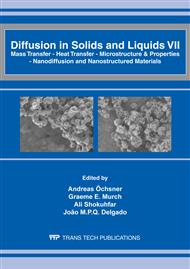p.525
p.530
p.536
p.542
p.547
p.555
p.561
p.567
p.573
Influence of Casting Conditions and Alloy Additions on the Zn22Al2Cu Structure
Abstract:
Zn-Al-Cu alloys are characterized by a number of beneficial properties that include good castability, good tribological properties and low energy input for forming the product. When compared to bronze, Zn-Al-Cu alloys have a lower density. Properties of Zn-Al-Cu can be improved by the partial or total replacement of copper with silicon and rare earth element additions. In the literature there are few studies on the effect of casting conditions and modifying the chemical composition through the introduction of alloy micro-additives on the alloy structure. The aim of this study was to determine the effect of casting conditions and silicon and rare earth element additions on the structure of Zn-22% Al-2%Cu alloy. The subjects examined were the unmodified alloy, the alloy with 1.5% Si and the alloy with 1.5% Si and rare earth elements (mich metal). Samples were cast in sand and graphite molds. The liquidus temperature for each of these examined samples was determined. Structure examinations were carried out in samples taken from the top, center and bottom of the ingot. In order to determine the microstructure of the examined structures metallographic examinations using an optical microscope and a scanning electron microscope with energy dispersive spectroscopy (EDS) capabilities, an X-ray microscope, was performed. Quantitive analysis on specific, characteristic microzones was performed based on the EDS X-ray spectroanalysis results.
Info:
Periodical:
Pages:
547-554
Citation:
Online since:
April 2012
Authors:
Keywords:
Price:
Сopyright:
© 2012 Trans Tech Publications Ltd. All Rights Reserved
Share:
Citation:


